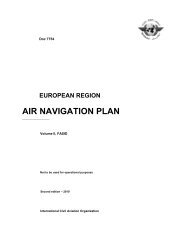7754 Vol 1 Flyleaf - ICAO Public Maps
7754 Vol 1 Flyleaf - ICAO Public Maps
7754 Vol 1 Flyleaf - ICAO Public Maps
Create successful ePaper yourself
Turn your PDF publications into a flip-book with our unique Google optimized e-Paper software.
V-4 EUR BASIC ANP<br />
13. Where justified by traffic density and/or its<br />
complexity, and taking into account relevant cost<br />
effectiveness aspects, ATS units should be provided with<br />
radar.<br />
14. Detailed considerations relevant to the provision<br />
of primary and secondary surveillance radar for ATS<br />
purposes are contained in Attachment G and K to Part IV<br />
— CNS of the EUR FASID as appropriate.<br />
15. In planning for the provision of radar, States<br />
should take account of existing or planned facilities in<br />
adjacent States in order to achieve a coherent system with<br />
adequate overlap of radar coverage in border areas. For<br />
economic reasons, planning for continuous and coherent<br />
en-route ATS radar services should allow for a maximum of<br />
shared use of radar facilities available in adjacent States.<br />
16. From the initial stages of planning for radar<br />
facilities, due consideration should be given to radar data<br />
processing and display aspects and to possibilities for future<br />
expansion of the use of such facilities, both as regards the<br />
area covered and the degree of sophistication.<br />
17. The radar coverage for en-route ATS purposes<br />
should be such as to permit the provision of radar services on<br />
all major ATS routes in the region, with due regard to the<br />
need to progress towards an “area control” service.<br />
18. Planning for an optimum deployment of radar<br />
facilities for en-route ATS purposes should be based on SSR<br />
with Mode C.<br />
19. Progressive improvements in the treatment of<br />
SSR-derived data for ATS purposes should be planned so<br />
that changes or replacement of existing SSR equipment are<br />
kept to a minimum. Relevant considerations are contained in<br />
Attachment I to Part IV — CNS of the EUR FASID.<br />
20. States whose ACCs are equipped with en-route<br />
radar should:<br />
25. Automatic data processing equipment should<br />
provide the controller with a display of at least the accurate<br />
position of the aircraft in the controller’s area of concern. In<br />
addition, the equipment should be such that in the event of<br />
temporary, partial or complete failure of any of its<br />
components, the controller will be able to revert safely to<br />
other means of operation (“fail-soft” concept). Specific<br />
considerations relevant to the use of automatic data<br />
processing equipment are still under development and will<br />
be contained in an Attachment to Part V.II — ATS of the<br />
EUR FASID. Considerations on computer assisted<br />
coordination processes are contained in Attachment E to Part<br />
a) arrange for a maximum use for flights in the en-route<br />
phase of the prescribed radar separation minima and/or<br />
the reduced procedural longitudinal separation minima<br />
based on radar monitoring;<br />
b) use primary and/or secondary surveillance radar for the<br />
purpose of monitoring air traffic and identifying civil<br />
aircraft in areas where they might otherwise be<br />
intercepted; and<br />
c) implement or update the communications links which are<br />
necessary to permit radar transfer of control between<br />
adjacent ACC (3.8, Part IV — CNS also refers).<br />
21. For radar services in major terminal areas and in<br />
certain en-route airspace, a complementary use of SSR and<br />
PSR coverage is needed. The requirements should be based<br />
on the nature of the traffic.<br />
22. Planning of changes in the coverage and radar<br />
services for en-route operations should be organized on a<br />
EUR region-wide basis.<br />
23. For the improvement of radar service based on<br />
SSR, advance techniques currently available (e.g. monopulse,<br />
large vertical aperture antennae, use of multi-radar<br />
information, etc.) should be exploited. In this connexion, the<br />
requirement for existing primary radar services to en-route<br />
operations should be kept under review.<br />
AUTOMATION IN ATS<br />
24. The decision to provide automatic data processing<br />
equipment for ATS purposes should be based on agreed<br />
criteria. These are still to be developed and will be contained<br />
in an Attachment to Part V.II — ATS of the EUR FASID in<br />
due course.<br />
[PANS-ATM, Attachment D]<br />
V.II — ATS of the EUR FASID.<br />
[PANS-ATM, Attachment D]<br />
26. Computer-assisted data exchange facilities should<br />
be used between ATC units in order to automate to the extent<br />
practicable the coordination between ATC units and<br />
therefore increase airspace capacity. Data exchange facilities<br />
shall be implemented in accordance with the methods of<br />
application specified in Attachment E to Part V.II — ATS of<br />
the EUR FASID.














